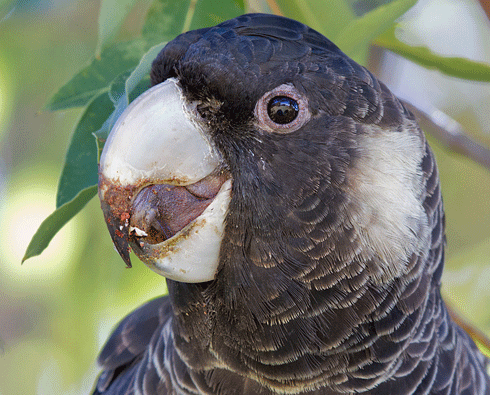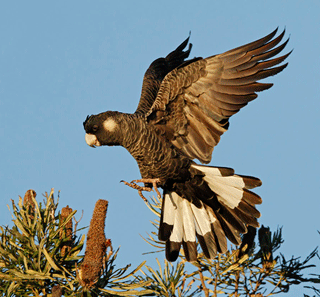
|
Published: 2 September 2013
Science and the future of WA’s black cockatoos
Black cockatoos are Western Australia’s icons of the air. Flying over the landscapes of the state’s southwest, their large black bodies, red-or-white panelled tails and distinctive wails can’t help but command attention. But black cockatoo numbers are declining, and never more rapidly than in the last few years.
The threats to their survival are common to much of Australia’s native fauna – clearing for urban development; removal of feeding (and roosting) habitat, in particular, mature marri, jarrah, salmon gum and other old, hollow-bearing eucalypts; and competition for remaining breeding hollows from galahs, corellas and feral honey bees.
Adding to these pressures, eucalypt seedlings needed for woodland recovery are being trampled by stock, and the birds themselves can fall victim to farmers and poachers.
Apart from these known causes of the cockatoos’ decline, much remains unknown and in urgent need of discovery.
The Great Cocky Count
Three species of black cockatoo are endemic to south-west WA. The most mobile and prominent, Carnaby’s black cockatoo, is also the most threatened and listed as endangered under the federal government’s Environment Protection and Biodiversity Conservation Act 1999.
The other two species – Baudin’s black cockatoo and the forest red-tailed black cockatoo –are both considered ‘vulnerable’ under federal legislation and ‘rare or likely to become extinct’ under WA law.
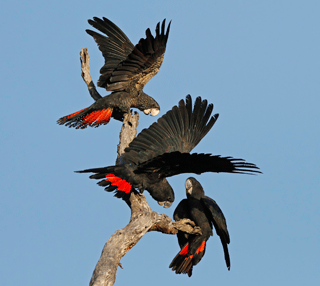
|
|
Forest red-tailed black cockatoo, which is listed under the EPBC Act as vulnerable. Credit:
Keith Lightbody
|
The greater prominence of Carnaby’s black cockatoo is due to its distribution. From late summer and throughout the winter months, the birds come into the more populated coastal regions in search of food. The other two species have traditionally remained in the tall wet forests south of Perth (Baudin’s) and in woodland and shrubland inland of the coast (forest red-tailed). Although the two latter species have recently begun to visit suburban Perth gardens more frequently, more effort has been invested in the study and conservation of the higher-profile Carnaby’s cockatoo.
To keeps tabs on populations of Carnaby’s cockatoos across their non-breeding range, Birdlife Australia (formerly Birds Australia) in conjunction with WA’s Department of Parks and Wildlife (DPaW) initiated the Great Cocky Count, a regular census of the birds. Now in its fifth year, the census compares the total numbers of birds at their roost sites over subsequent years.
Until these formal counts commenced, it was thought the population had decreased by about half over the course of almost half a century.
However, in 2011, the number of cockatoos observed in the greater Perth region suddenly declined by more than one-third compared to the previous year, causing concern among the scientific community. The reason for this rapid decline remains unknown and has brought the need for further urgent research into sharp relief.
More ecological mysteries
According to wildlife veterinarian, Dr Kris Warren of Murdoch University, little is known about the prevalence of diseases in black cockatoos. An outbreak of an unidentified disease in 2009 was considered the most likely cause for a 50 per cent reduction in the breeding population of Carnaby’s cockatoos at an important breeding site at Coorow.
Given the already low numbers of these birds, the species can ill-afford to lose large numbers of individuals through unpredictable events. Dr Warren, along with colleagues from Murdoch University, Perth Zoo, DPaW and CSIRO, is contributing to a large-scale study that seeks to provide much needed information on the health and ecology of the three cockatoo species. They are hopeful this research will be funded through the Wildlife Biodiversity Cooperative Research Centre (CRC) which is currently under consideration by the Federal Government.
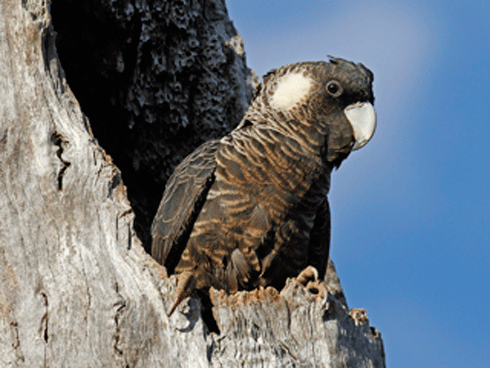
|
|
A Carnaby’s cockatoo nesting: all three species rely on the availability of nesting hollows high up on mature trees. Credit:
Keith Lightbody
|
‘Our preliminary research has shown us that two viral infections common to other cockatoos, beak-and-feather disease (BDFV) and avian polyomavirus (APV) do occur in nestlings,’ says Dr Warren.
‘We now need to monitor the nestlings and adult black cockatoos for signs of clinical disease to understand how their populations may be affected over time.’
A second factor that needs investigation is the age of cockatoos in wild populations. Uncertainty about the level of juvenile recruitment and concerns that wild flocks of black cockatoos may comprise large numbers of older birds is being addressed using the innovative method of pentosidine analysis.
Pentosidine, a skin metabolite that increases with age, will be measured in wild birds for the first time. The study’s findings will contribute to a better understanding of the age demographics and life histories of the cockatoos.
A third tier of the study will identify critical foraging, breeding and roosting habitat. Satellite and ground-based tracking of all three species will provide important information about long-term and seasonal movements and the birds’ behaviour, ecology and foraging patterns. Identifying critical feeding, watering and breeding sites are priority actions under the species’ recovery plan and will help to prioritise them for protection.
The question of food
Understanding how and where the threatened cockatoos feed is central to their conservation management.
Due to the loss of much of their former habitat – almost two-thirds has been cleared – the birds are increasingly reliant on introduced food sources to supplement their diet. This can lead to fatal confrontations with farmers – up to 300 black cockatoos, mostly Baudin’s in search of fruit, are shot illegally in any one year.
Without sufficient native foods such as hakeas and banksias, the adaptable Carnaby’s black cockatoos are utilising exotic trees such as liquidambar, and farmed macadamia and pecan – highly productive trees that provide food during the non-breeding season.
PhD student Christine Groom from DPaW is satellite-tracking cockatoos that have been rehabilitated following vehicle strikes or illnesses to determine how the birds survive in cities like Perth.
‘Understanding how far they travel to feed and how loyal they are to particular night roosts and foraging sites will inform the conservation strategy for the cockatoos and enable urban planning decisions to consider the needs of the cockatoos,’ she says.
The reliance of a threatened species on cultivated foods has its risks. These new food resources have clear advantages for the cockatoos. Pine plantations, for one, produce food much more quickly than native food plants and have been a staple food source for Carnaby’s cockatoos since the 1940s. The birds have been known to remove entire crops of pine cones in a year.
With this important food source scheduled to be phased out by 2031, alternative food sources will need to be planted soon to avoid a significant negative impact on the cockatoos.
Rain bird
WA’s Noongar people refer to Carnaby’s cockatoo as a ‘harbinger of rain’ – when the birds arrive at their breeding areas, the odds are that rain will soon follow.
A decades-long study by now-retired CSIRO scientist, Dr Denis Saunders, at Coomallo Creek near Badgingarra has shown that rain is also a good indicator of breeding success.
A drier autumn – a possible consequences of climate change – results in later breeding and a shorter egg-laying season, which in turn leaves chicks to be raised in hotter weather and makes foraging more strenuous. The implication may be that fewer fledglings will survive.
A changing climate is one of many challenges to WA’s threatened black cockatoos, but the more information science can provide, the more effective will be our conservation strategies to help keep these iconic birds aloft.
|
Nestled in the Perth hills is the Kaarakin Black Cockatoo Conservation Centre, run by the not-for-profit Black Cockatoo Preservation Society. The largely volunteer team at the centre work to rescue, rehabilitate and return sick or injured birds to the wild. |
Phil Digney, the centre’s manager, says about 40 per cent of the birds they rescue have been injured in a vehicle accident, and 40 per cent are abandoned juveniles. Of the rest, most have been shot or accidentally poisoned, with a few (three to four per cent) that have been seized after being held illegally. |
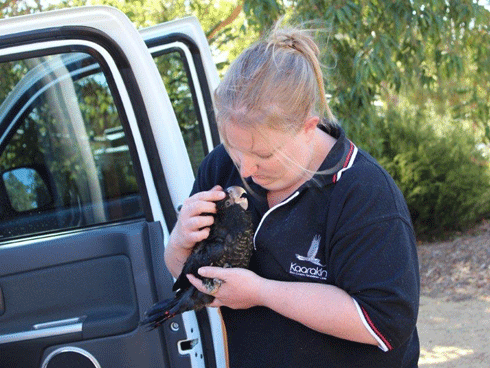
Louise, the vet nurse at the Kaarakin centre, with one of her charges – the centre’s cockatoo ‘ambulance’ can take as little as 10 minutes to respond to emergency calls. Credit: Kaarakin
|
Unfortunately, many rescued birds die, but of those that survive around half are eventually released back into the wild, according to Mr Digney. The rest, he says, are used in captive breeding programs. |


